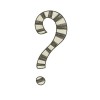All artists have the same elements of art with which to work. They are line, shape, form, color, value, texture, and space. All the art in the world is done with one or more of these elements. If we want to make art, we need to understand these seven elements of art.
We can separate the art elements to study them to see how they look and how they can be used in making art. Most of the time, however, they are combined when they are used in painting, sculpture, or other forms of art.
Line: Line is a mark made by a pointed tool – brush, pencil, stick, pen, etc. and is often defined as a moving dot. It can vary in width, direction, curvature, length, and even color. A line is created by the movement of a tool and pigment, and often suggests movement in a drawing or painting.
Shape: Shape is an area that is contained within an implied line, or is seen and identified because of color or value changes. Shapes have two dimensions, length and width, and can be geometric or freeform (organic). Design is basically the planned arrangement of shapes in a work of art.
Form: Shape and form have the same qualities except shape is two-dimensional and form is three-dimensional; it describes volume and mass. Both may be organic or inorganic, freeform or geometric, natural or man-made.
Color: Color depends on light because it is made of light. There must be light for us to see color. A red shirt will not look red in the dark, where there is no light. The whiter the light, the more true the colors will be. There are three properties or characteristics of color; hue, value, and intensity. Hue is simply another name for a color.
Value: Value refers to dark and light; the value scale refers to black and white with all gradations of gray in between. Value contrasts help us to see and understand a two-dimensional work of art. Value contrast is also evident in colors, which enables us to read shapes in a painting.
Texture: Texture refers to the surface quality of artwork and describes the feel of an actual surface. Sculptures, ceramic ware, or collages may have rough or grainy surfaces – or actual textures you can feel. A drawing, print, or painting can be made to look like a textured surface and has simulated or implied texture because it may look like texture, but actually is on a smooth flat surface.
Space: Actual space is a three-dimensional volume that can be empty or filled with objects. It has width, height, and depth. Space in a painting is an illusion that creates a feeling of depth. The object or the picture plane is divided into positive space (the object itself) and negative space (the surrounding area, or background). Various techniques can be used to show space.
Principles of Design
Once you are familiar with the Elements of Art, you need to understand composition or visual design. This helps artists use the Principles of Design to make their artwork better. The Principles of Design are balance, contrast, emphasis, movement, pattern, rhythm, and unity with variety. They help artists organize any kind of artwork so it feels more comfortable to viewers.
Balance: Balance refers to the arrangement of elements on either side of a center line. Shapes, colors, and values can be arranged to create a sense of comfort and balance. Most successful compositions achieve balance in one of two ways: symmetrically (formal balance) or asymmetrically (informal balance). Radial symmetry is the result of arranging elements equally around a center point.
Contrast: Contrast refers to differences in values, colors, or other art elements. Contrast is used to make artwork exciting.
Emphasis: In artwork, visual emphasis is placed on the most important parts of the work (focal area). Other things in the artwork may be important, but we look in the focal area to see what the artist emphasized.
Movement: Artists use visual movement to guide the viewer eye to move along edges and lines, and paths made of connect shapes of similar value or color. Such movement often leads us to the focal area and gives our work a sense of unity and organization.
Pattern: Patterns are made in art when the same shapes or elements are repeated again and again. Pattern can be regular or irregular. Regular patterns result with elements that are carefully controlled and repeated accurately whereas irregular patterns are found with random repeated elements that don’t seem planned, as found in nature.
Rhythm: Rhythm is based on the repetition of art elements. Developing rhythm in a work of art will help unify the surface and create a feeling of planned organization. Regular rhythm is planned by using the same elements repeatedly, but not necessarily exactly. Irregular rhythm is developed when elements are repeated but with more variety, i.e. a city skyline, or waves in the ocean.
Unity: Unity makes a work of art feel complete and finished because everything (such as color, texture, repetition, movement, and the subject) seems to be in harmony and work together. While variety keeps the artwork interesting, consistency will create unity. If everything looks too much alike, the work may appear dull, whereas unity with variety is much more pleasing.

